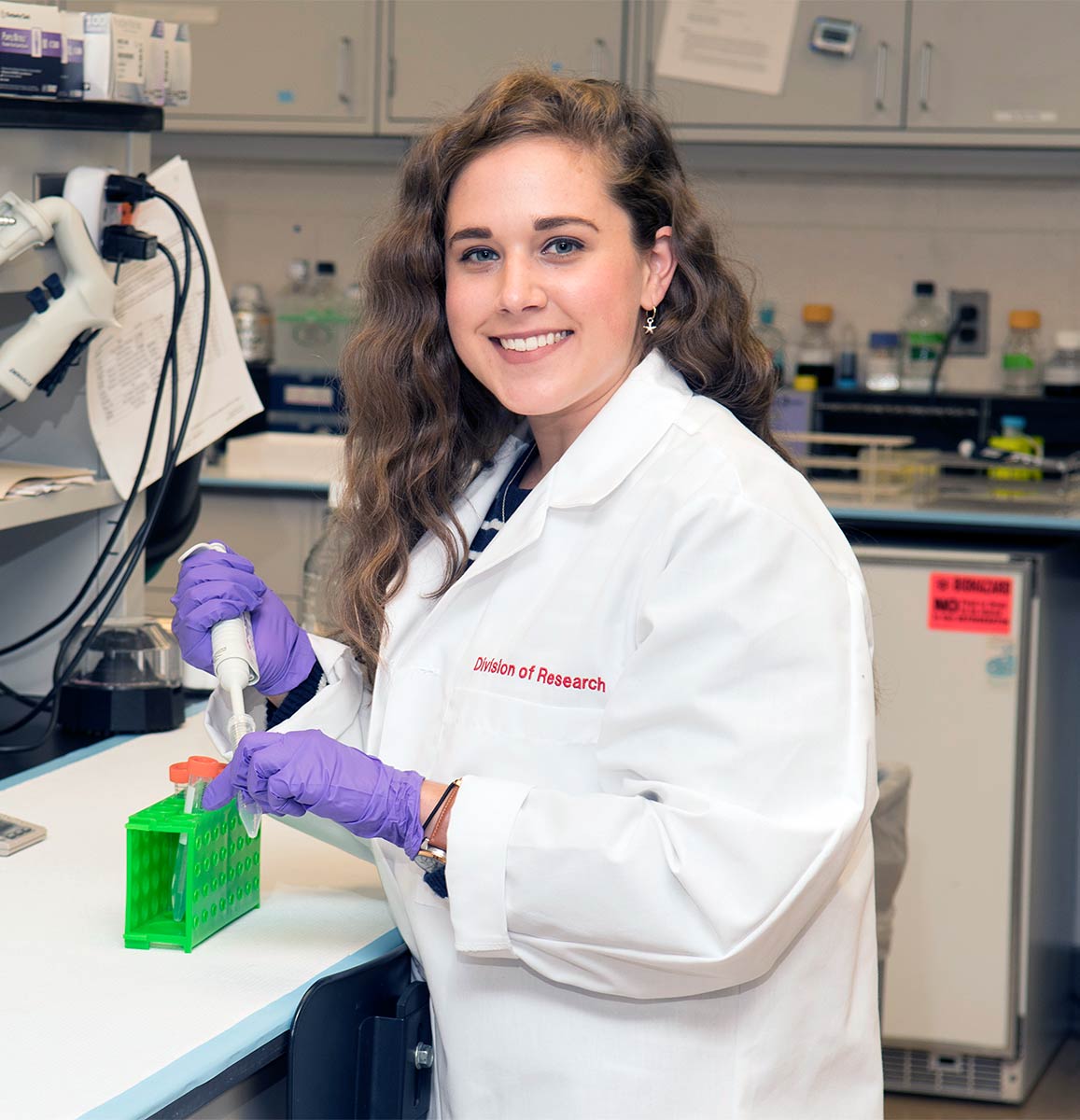Student Research Spotlight
Nicole McAndrew (DO '20)
June 18, 2018 Nicole McAndrew's (DO '20) research hopes to shed more light on neuroblastoma, a little
understood form of pediatric cancer.
Nicole McAndrew's (DO '20) research hopes to shed more light on neuroblastoma, a little
understood form of pediatric cancer.
Neuroblastoma largely affects immature or developing cells, most often found in infants
and young children. It is rare in children older than 10 years. There are roughly
800 new cases of neuroblastoma in the US each year, and its cause remains largely
unknown. Nicole McAndrew (DO ’20) is studying cellular mechanisms associated with
this form of cancer, in hopes of someday developing an effective therapeutic.
What are you studying?
I am studying a specific type of cancer called Neuroblastoma, which is the most common
solid tumor in infants, accounting for 6 percent of all childhood cancers and 15 percent
of all tumor deaths in children. Neuroblastoma arises from immature nerve cells in
many areas of the body, most commonly being the adrenal glands that sit on top of
the kidneys.
These immature cells can differentiate into neuron-like cells after being exposed
to many different exogenous agents. My research looked into neuroblastoma cells’ sensitivity
to a specific Vitamin A derivative called Retinoic Acid. The study looked at the effects
of nanomolar concentrations of retinoic acid in two different neuronal cell lines.
Each cell line was treated with retinoic acid at many different concentrations for
up to 6 days. Morphology changes were quantified, protein expression and localization
were observed using immunocytochemistry, and calcium imaging using pharmacological
agents was used to identify neuron-like activity.
The results of these experiments showed that one specific cell line developed neuronal
characteristics in response to the retinoic acid treatment. Some noted changes were
the development of neurite processes and the expression of neurofilament-200, which
provides structural support for the axon. There was also increased responsiveness
to acetylcholine and epinephrine, and decreased responsiveness to nicotine. Essentially,
this means that the process for these cells’ differentiation into specific neuronal
phenotypes was ultimately driven by Retinoic acid.
Other important results showed that retinoic acid treatment increased nuclear trafficking
of a protein CRABP2, which aids in the transport of retinoic acid to the nucleus and
is associated with cell signaling pathways related to differentiation.
Overall, the results of the study showed that specific nanomolar concentrations of
retinoic acid could induce structural as well as functional neuronal changes in specific
neuroblastoma cell lines using CRABP2.
What prompted you to pursue research?
I started to become interested in research while taking a cellular biology course
as an undergraduate at the University of Scranton. At the end of the term I was required
to complete my own research project. This small class assignment prompted me to join
my teacher’s lab, design and conduct my own research project, and expand on my ideas
that I had in that class. I liked the challenge and the critical thinking that came
along with research over the past few years, but I also loved the freedom that the
lab gave me. It is a great feeling to see how far my research has come.
What experience do you have conducting research?
Since 2013 I have conducted my neurobiology research with my mentor, George Gomez,
PhD, associate professor, biology, at the University of Scranton.
What were your responsibilities in your research project?
I developed and conducted this research project, along with a fellow classmate at
Scranton, Emily Harasym and Dr. Gomez. Some of my responsibilities in the lab consisted
of cell culturing, retinoic acid treatment, as well as immunocytochemistry and immunofluorescence
microscopy. I also helped in writing and editing our paper for publication. I have
prepared and presented posters of this research at the American Society for Cell Biology
conferences in Philadelphia and San Diego.
What is the broader impact of your research?
The cause of neuroblastoma is not clearly understood. The majority of cases are sporadic
and non-familial and most are very aggressive and therefore don’t clinically manifest
themselves until they have already spread to other parts of the body. This makes it
very difficult for an early and accurate diagnosis. I believe that this study can
provide insight into the truly complex mechanism of cancer proliferation, neuronal
development, and therefore provide implications for chemotherapeutic design for the
near future.
You May Also Like:
About Philadelphia College of Osteopathic Medicine
Established in 1899, Philadelphia College of Osteopathic Medicine (PCOM) has trained
thousands of highly competent, caring physicians, health practitioners and behavioral
scientists who practice a “whole person” approach to care—treating people, not just
symptoms. PCOM, a private, not-for-profit accredited institution of higher education,
operates three campuses (PCOM, PCOM Georgia and PCOM South Georgia) and offers doctoral degrees in clinical psychology, educational psychology, osteopathic
medicine, pharmacy, physical therapy, and school psychology. The college also offers
graduate degrees in applied behavior analysis, applied positive psychology, biomedical
sciences, forensic medicine, medical laboratory science, mental health counseling,
physician assistant studies, and school psychology. PCOM students learn the importance
of health promotion, research, education and service to the community. Through its
community-based Healthcare Centers, PCOM provides care to medically underserved populations.
For more information, visit pcom.edu or call 215-871-6100.
Contact Us
For general media inquiries, please contact the Office of Marketing and Communications
at 215-871-6300 or communications@pcom.edu. Visit our media relations page to view contact information for public relations personnel.
Connect with PCOM

 Nicole McAndrew's (DO '20) research hopes to shed more light on neuroblastoma, a little
understood form of pediatric cancer.
Nicole McAndrew's (DO '20) research hopes to shed more light on neuroblastoma, a little
understood form of pediatric cancer.